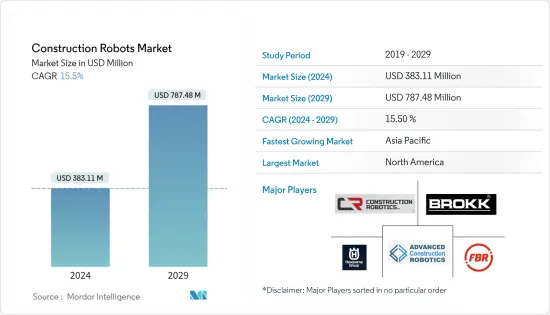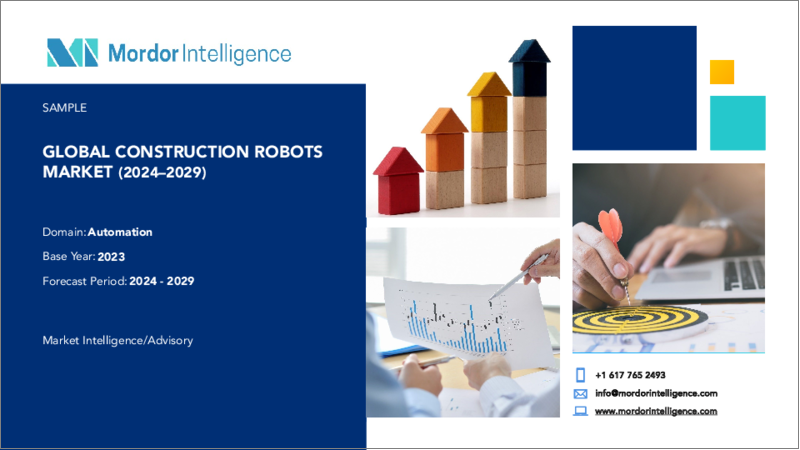|
|
市場調査レポート
商品コード
1445462
建設ロボット:市場シェア分析、業界動向と統計、成長予測(2024~2029年)Construction Robots - Market Share Analysis, Industry Trends & Statistics, Growth Forecasts (2024 - 2029) |
||||||
|
● お客様のご希望に応じて、既存データの加工や未掲載情報(例:国別セグメント)の追加などの対応が可能です。 詳細はお問い合わせください。 |
|||||||
| 建設ロボット:市場シェア分析、業界動向と統計、成長予測(2024~2029年) |
|
出版日: 2024年02月15日
発行: Mordor Intelligence
ページ情報: 英文 119 Pages
納期: 2~3営業日
|
- 全表示
- 概要
- 目次
建設ロボット市場規模は、2024年に3億8,311万米ドルと推定され、2029年までに7億8,748万米ドルに達すると予測されており、予測期間(2024年から2029年)中に15.5%のCAGRで成長します。

都市化の進行、工業化の浸透、高度な建設・解体作業の要因が市場の収益成長を推進しています。
主なハイライト
- 建設中の建築資材の資源と材料廃棄物の削減に対する建設組織の関心の高まりにより、建設ロボット市場の採用が促進されるでしょう。さらに、オートデスクは、一般的な建設現場で発生する廃棄物の正確な数字を把握することは困難ですが、いくつかの建設組織は、建設現場に輸送される建築資材の総重量の30%近くが廃棄されていると考えていることを明らかにしています。
- さらに、プロジェクトの建設時間の短縮により、建設ロボットの成長が促進されます。オーストリアに拠点を置く建設用モバイル3DプリンティングロボットのメーカーであるPrintstonesは、最新の製造ロボットを発売しました。モジュラー設計はBaubotを示しており、サードパーティによる顧客による変更が簡単に可能です。「多機能建設ロボット」と表現されるこのローバー風のデバイスは、単なるコンクリート 3Dプリントの枠を超えています。材料の輸送、溶接、フライス加工、促進要因、切断、塗装、さらにはレンガ積みなど、多くの柔軟な製造プロセスに適しています。
- さらに、2022年 5月に、Dusty Roboticsは4,500万米ドルを調達し、高度なロボット工学を通じて建設エラーを排除する業界初のハードウェア、ソフトウェア、およびサービスのソリューションを発表しました。 FieldPrinterは、ハードウェア、ソフトウェア、サービスを組み合わせて床にフルサイズで印刷することで、建設現場のデジタル床技術を自動化します。
- 新しいインフラストラクチャのニーズが高まる中、自動化された建設ソリューションは今後数年間で勢いを増し、市場にプラスの影響を与えると予想されます。 Redshiftによると、都市部に住むと予想される70億人の人口をサポートするには、業界は現在から2050年まで毎日13,000棟の建物を建設する必要があります。
- さらに、技術の取得と維持に関連する高額なコストは、建設ロボットの導入における課題の1つです。テクノロジーの購入と実装には費用がかかります。したがって、売上高と市場競争が良好な企業だけがこれらのテクノロジーを購入できるのです。これに加えて、自動化テクノロジーを更新して維持する必要があり、そのほとんどはそれに費用がかかります。新しいロボット機器のメンテナンスコストは、優れた技術者のニーズにより高くなっています。
- 過去のCOVID-19の発生は建設業界に悪影響を及ぼし、ロックダウンの最初の数カ月は建設工事が停止しました。しかし、この技術がもたらす安全性の利点により、製品の需要が高まり、業界からの採用への関心が高まりました。
建設ロボット市場動向
商業ビルと住宅ビルが建設ロボットの最大の用途となる
- 新しい商業インフラや住宅インフラのニーズが高まる中、自動建設ソリューションは今後数年間で勢いを増し、市場にプラスの影響を与えると予想されます。 Redshiftによると、都市部で予想される70億人の人口をサポートするには、業界は現在から2050年まで毎日13,000棟の建物を建設する必要があります。
- 都市化は指数関数的に増加しています。世界銀行のデータによると、世界人口の約55%、つまり42億人が都市に住んでおり、この傾向は今後数年間続くと予想されています。 2050年までに、世界の都市人口は2倍になり、10人中7人近くが都市に住むようになると予想されています。これにより、自動化や人工知能などの技術変化がもたらされ、都市の複数の課題に対処するためにロボット工学を含むさまざまな技術が急速に導入されることが予想されます。
- 人口問題研究所が発行した2021年の世界人口データシートによると、北米は世界で最も都市化された大陸であり、人口の82%が都市に住んでいます。ラテンアメリカとカリブ海諸国では、都市化の度合いは79%に達しました。世界の都市部に住む人々の割合は、2020年の56%から2050年には70%に増加すると予測されています。
- 都市化の必要性と規模は、手頃な価格の住宅、交通網の充実した交通システム、その他の基本的な生活インフラに対する需要の加速への対応などの課題をもたらしています。世界銀行によると、非公式入植地に住む約10億人の都市貧困層が紛争を引き起こす機会に近づいており、その60%が都市部で強制的に避難させられているといいます。
- 世界の主要経済国は、都市部の住宅価格をコントロールし、低所得層の国民が住宅に買えるよう、住宅ソリューションをさらに構築することを検討しています。北米と欧州の主要経済国の都市計画部門は、市場向けにさらに多くの住宅を建設することを検討しており、これにより一部の価格はある程度緩和されます。この分野では、構築にかかる時間が大幅に短縮され、持続可能な3Dプリンティングソリューションが、今後数年間で需要が高まると予想されます。主にアジア太平洋地域に位置する成長経済諸国では、インフラストラクチャーと住宅ソリューションへの需要により、建設技術への投資が加速すると予想されます。
- 住宅やアパートなどの住宅建設の増加により、予測期間中に建設ロボットの需要が促進されると予想されます。
アジア太平洋が市場を独占する
- アジア太平洋は建設ロボット市場にとって重要な地域の1つであり、主要 3か国はインド、中国、日本です。この地域での3Dプリント住宅の開発の増加により、市場の成長が促進されると予想されます。
- さらに、3Dプリンティングの需要が高いため、さまざまな国際企業が地域でのサービスを拡大しようとしています。たとえば、2022年 6月、デンマークの建築用 3Dプリンティング技術開発会社COBOD Internationalは、最先端のコンクリート 3Dプリンティング技術をオーストラリアに導入し、その強化を図るという同社の戦略の一環として、オーストラリアの企業Fortexと新たな販売契約を締結しました。アジア太平洋地域における3D建設プリンティング。
- アジアはパンデミックの前からすでにロボット工学と産業オートメーションを完全に受け入れていました。新型コロナウイルス感染症後の世界では、これらのテクノロジーの導入と、それらを統合する製造、物流、建設などの業界が今後も増加していくでしょう。
- 都市化の進行により、市場の成長に対する需要がさらに創出されることが予想されます。中国国家統計局によると、2022年には中国の人口の約65.2%が都市に住んでいた。この国の都市化率は過去数十年間で大幅に増加しました。
- 建設業界の見通しは楽観的であり、人材に対する需要は非常に高いです。それにもかかわらず、継続的かつ膨大な建設作業に直面して、業界は建設効率を向上させ、作業員と現場の安全を確保し、それによって全体的な生産性と費用対効果を高める必要があります。このような動向は、予測期間中に調査された市場にプラスの成長をもたらすと予想されます。
建設ロボット業界の概要
建設ロボット市場は、Brokk AB(Lifco Public AB)、Husqvarna AB、Construction Robotics LLC、FBR Ltd.、Advanced Construction Robotics Inc.などの大手企業の存在により細分化されています。市場の企業はパートナーシップ、イノベーションなどの戦略を採用しています。、および製品提供を強化し、持続可能な競争上の優位性を獲得するための買収。
2022年 12月、医療用および産業用外骨格技術の業界リーダーであるEkso Bionicsは、モーション分野の世界的リーダーであるParker Hannifin Corporation(以下「パーカー」)からヒューマンモーションアンドコントロール(「HMC」)ビジネスユニットを買収すると発表しました。そして制御技術。この買収には、Indego下肢外骨格製品ラインと、ロボット支援の矯正器具および補綴装置の開発計画が含まれていました。
2022年 10月、遠隔制御解体ロボットの世界大手メーカーであるBrokkは、塗料やアスベストなどの材料除去、表面処理、壁や床の研磨用のBROKK SURFACE GRINDER 530(BSG 530)アタッチメントの追加を発表しました。、および改修および修復用途の天井。
2022年 8月、ハスクバーナコンストラクションは、この地域の主要な産業用ツールおよび機器のサプライヤーであるAABToolsと戦略的パートナーシップを締結しました。 Husqvarna Constructionのオーガニック製品は、AABToolsによって販売される予定でした。これには、頑丈で高周波のコンクリートコアリングマシン、レンガと鉄筋コンクリート用に設計されたウォールソー、遠隔制御の解体ロボット、および20種類以上のハンドヘルド電動カッター、集塵機が含まれます。、フロアソー。
その他の特典
- エクセル形式の市場予測(ME)シート
- 3か月のアナリストサポート
目次
第1章 イントロダクション
- 調査の前提条件と市場の定義
- 調査範囲
第2章 調査手法
第3章 エグゼクティブサマリー
第4章 市場洞察
- 市場概要
- 業界の魅力-ポーターのファイブフォース分析
- 供給企業の交渉力
- 買い手の交渉力
- 新規参入業者の脅威
- 代替品の脅威
- 競争企業間の敵対関係の激しさ
- COVID-19の市場への影響
第5章 市場力学
- 市場促進要因
- 急速な都市化
- 労働者の安全に関する政府の厳しい規制
- 市場抑制要因
- 高額な設備とセットアップのコスト
第6章 市場セグメンテーション
- タイプ別
- 解体
- レンガ積み
- 3Dプリント
- その他のタイプ
- 用途別
- 公共インフラ
- 商業ビルおよび住宅ビル
- その他の用途
- 地域別
- 北米
- 欧州
- アジア太平洋
- 世界のその他の地域
第7章 競合情勢
- 企業プロファイル
- BROKK AB(Lifco publ AB)
- Husqvarna AB
- Construction Robotics LLC
- FBR Ltd.
- Advanced Construction Robotics Inc.
- Dusty Robotics
- Apis Cor
- COBOD International AS
- Ekso Bionics
第8章 投資分析
第9章 市場の将来
The Construction Robots Market size is estimated at USD 383.11 million in 2024, and is expected to reach USD 787.48 million by 2029, growing at a CAGR of 15.5% during the forecast period (2024-2029).

The growing urbanization, industrialization penetration, and advanced construction & demolition operation factors are driving market revenue growth.
Key Highlights
- The increasing focus of construction organizations on reducing building materials' resources and material waste during construction will drive the adoption of the construction robot market. Further, Autodesk identifies that while it is difficult to get exact figures of the waste produced on a typical construction site, several construction organizations have thought that nearly 30% of the total weight of building materials transported to a building site gets wasted.
- Further, reducing the construction time of the projects is aiding the growth of construction robots. Printstones, an Austria-based manufacturer of mobile 3D printing robots for construction, has launched its latest manufacturing robot. A modular design indicates the Baubot, which easily allows third-party customer modifications. Described as a 'multi-functional construction robot,' the rover-Esque device goes beyond concrete 3D printing. It qualifies for many flexible manufacturing processes such as material transportation, welding, milling, screwdriver, cutting, painting, and even bricklaying.
- Further, in May 2022, Dusty Robotics raised USD 45 million to announce the Industry's First Hardware, Software, and Services Solution to Destroy Construction Errors Through Advanced Robotics. FieldPrinter automates digital floor techniques on construction sites by printing them full-size on the floor through a mixture of hardware, software, and services.
- With the growing need for new infrastructure, automated construction solutions are expected to gain momentum over the coming years and impact the market positively. According to Redshift, the industry must build 13,000 buildings daily from now to 2050 to support an expected population of seven billion living in urban areas.
- Furthermore, high costs associated with acquiring and maintaining the technologies are one of the challenges in implementing construction robotics. The purchase, along with the implementation of the technologies, is costly. Therefore, only firms with a good turnover and market competition can afford these technologies. In addition to this, automation technologies need to be updated and maintained, and most of them are expensive to do it. The maintenance cost for the new robotics equipment is higher because of the exceptional technician's needs.
- The past outbreak of COVID-19 adversely affected the construction industry, with construction work coming to a standstill in the initial months of the lockdown. However, the product demand witnessed an increased interest in adoption from the industry owing to the safety benefits offered by the technology.
Construction Robots Market Trends
Commercial and Residential Buildings to be the Largest Application for Construction Robots
- With the growing need for new commercial and residential infrastructure, automated construction solutions are expected to gain momentum over the coming years and impact the market positively. According to Redshift, the industry must build 13,000 buildings daily from now to 2050 to support an expected population of seven billion in urban areas.
- Urbanization is rising at an exponential rate. According to World Bank data, about 55% of the world's population, or 4.2 billion people, live in cities, and the trend is expected to continue over the coming years. By 2050, the urban population worldwide is expected to double, with nearly seven out of 10 people living in cities. This is expected to bring about technological changes such as automation and artificial intelligence and rapidly deploy various technologies, including robotics, to address multiple urban challenges.
- According to the World Population Data Sheet 2021, published by the Population Reference Bureau, North America was the most urbanized continent worldwide, with 82% of the population living in cities. In Latin America and the Caribbean, the degree of urbanization stood at 79%. It is projected that the share of people living in urban areas globally will increase from 56% in 2020 to 70% in 2050.
- The need and scale of urbanization are bringing challenges that include meeting accelerated demand for affordable housing, well-connected transport systems, and other basic infrastructure for living. According to the World Bank, nearly one billion urban poor who live in informal settlements are near opportunities that result in conflicts, which is leading to 60% of them being forcibly displaced in urban areas.
- Major economies worldwide are considering building more housing solutions to control the price of homes in urban areas so that lower-income citizens can afford them. Urban planning departments across major economies in North America and Europe are looking to build more housing for the market, which will somewhat moderate some prices. This is where 3D printing solutions that consume significantly less time to build and are sustainable are expected to gain traction in demand over the coming years. The demand for infrastructure and housing solutions in growing economies, mainly situated in the Asia-Pacific region, is expected to accelerate their investment in construction technologies.
- The growing construction of residential places like homes and apartments is expected to propel the demand for construction robots over the forecast period.
Asia-Pacific to Dominate the Market
- Asia-Pacific is one of the significant regions for the construction robotics market, with the three major countries being India, China, and Japan. The increasing development of 3D-printed houses in the region is expected to boost market growth.
- Additionally, various international companies are looking to expand their regional offerings due to the high demand for 3D printing. For instance, in June 2022, COBOD International, a Danish developer of 3D construction printing technology, signed a new distribution agreement with Fortex, an Australian company, as part of the company's strategy to bring cutting-edge concrete 3D printing technology to Australia and strengthen 3D construction printing in the Asia-Pacific region.
- Asia was already fully embracing robotics and industrial automation before the pandemic. In a post-COVID world, the adoption of these technologies and industries that integrate them, like manufacturing, logistics, and construction, will continue to rise.
- The increasing urbanization is further expected to create demand for market growth. As per the National Bureau of Statistics of China, in 2022, approximately 65.2% of the population in China lived in cities. The urbanization rate has increased significantly in the country over the last few decades.
- The prospect of the construction industry is optimistic, with a strong demand for manpower. Nevertheless, in the face of a continuous and huge amount of construction work, the industry needs to improve construction efficiency and ensure worker and site safety, thereby enhancing overall productivity and cost-effectiveness. Such trends are expected to create positive growth for the market studied over the forecast period.
Construction Robots Industry Overview
The construction robots market is fragmented with the presence of major players like Brokk AB (Lifco Public AB), Husqvarna AB, Construction Robotics LLC, FBR Ltd., and Advanced Construction Robotics Inc. Players in the market are adopting strategies such as partnerships, innovations, and acquisitions to enhance their product offerings and gain a sustainable competitive advantage.
In December 2022, Ekso Bionics, an industry leader in exoskeleton technology for medical and industrial use, announced the acquisition of the Human Motion and Control ("HMC") Business Unit from Parker Hannifin Corporation ("Parker"), a global leader in motion and control technologies. The acquisition included the Indegolower limb exoskeleton line of products as well as the planned development of robotic-assisted orthotic and prosthetic devices.
In October 2022, Brokk, the world's leading manufacturer of remote-controlled demolition robots, announced the addition of the BROKK SURFACE GRINDER 530 (BSG 530) attachment for material removal, such as paint and asbestos, surface preparation, and polishing on walls, floors, and ceilings in renovation and restoration applications.
In August 2022, Husqvarna Construction entered into a strategic partnership with AABTools, the region's leading industrial tools and equipment supplier. Husqvarna Construction's organic products were to be distributed by AABTools, including heavy-duty and high-frequency concrete coring machines, wall saws designed for brick and reinforced concrete, remote-controlled demolition robots, and twenty-plus models of handheld power cutters, dust extractors, and floor saws.
Additional Benefits:
- The market estimate (ME) sheet in Excel format
- 3 months of analyst support
TABLE OF CONTENTS
1 INTRODUCTION
- 1.1 Study Assumptions and Market Definition
- 1.2 Scope of the Study
2 RESEARCH METHODOLOGY
3 EXECUTIVE SUMMARY
4 MARKET INSIGHTS
- 4.1 Market Overview
- 4.2 Industry Attractiveness - Porter's Five Forces Analysis
- 4.2.1 Bargaining Power of Suppliers
- 4.2.2 Bargaining Power of Buyers
- 4.2.3 Threat of New Entrants
- 4.2.4 Threat of Substitutes
- 4.2.5 Intensity of Competitive Rivalry
- 4.3 Impact of COVID-19 on the Market
5 MARKET DYNAMICS
- 5.1 Market Drivers
- 5.1.1 Rapid Urbanization
- 5.1.2 Stringent Government Regulations for Worker's Safety
- 5.2 Market Restraints
- 5.2.1 High Equipment and Setup Costs
6 MARKET SEGMENTATION
- 6.1 By Type
- 6.1.1 Demolition
- 6.1.2 Bricklaying
- 6.1.3 3D Printing
- 6.1.4 Other Types
- 6.2 By Application
- 6.2.1 Public Infrastructure
- 6.2.2 Commercial and Residential Buildings
- 6.2.3 Other Applications
- 6.3 By Geography
- 6.3.1 North America
- 6.3.2 Europe
- 6.3.3 Asia-Pacific
- 6.3.4 Rest of the World
7 COMPETITIVE LANDSCAPE
- 7.1 Company Profiles
- 7.1.1 BROKK AB (Lifco publ AB)
- 7.1.2 Husqvarna AB
- 7.1.3 Construction Robotics LLC
- 7.1.4 FBR Ltd.
- 7.1.5 Advanced Construction Robotics Inc.
- 7.1.6 Dusty Robotics
- 7.1.7 Apis Cor
- 7.1.8 COBOD International AS
- 7.1.9 Ekso Bionics




